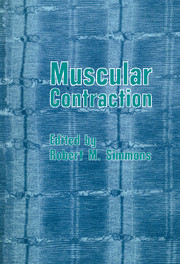Book contents
- Frontmatter
- Contents
- Dedication
- Contributors
- Preface
- 1 A. F. Huxley: an essay on his personality and his work on nerve physiology
- 2 A. F. Huxley's research on muscle
- 3 Ultraslow, slow, intermediate, and fast inactivation of human sodium channels
- 4 The structure of the triad: local stimulation experiments then and now
- 5 The calcium-induced calcium release mechanism in skeletal muscle and its modification by drugs
- 6 Hypodynamic tension changes in the frog heart
- 7 Regulation of contractile proteins in heart muscle
- 8 Differential activation of myofibrils during fatigue in twitch skeletal muscle fibres of the frog
- 9 High-speed digital imaging microscopy of isolated muscle cells
- 10 Inotropic mechanism of myocardium
- 11 Regulation of muscle contraction: dual role of calcium and cross-bridges.
- 12 Fibre types in Xenopus muscle and their functional properties.
- 13 An electron microscopist's role in experiments on isolated muscle fibres.
- 14 Structural changes accompanying mechanical events in muscle contraction.
- 15 Mechano-chemistry of negatively strained cross-bridges in skeletal muscle.
- 16 Force response in steady lengthening of active single muscle fibres.
- References
- Index
12 - Fibre types in Xenopus muscle and their functional properties.
Published online by Cambridge University Press: 07 September 2010
- Frontmatter
- Contents
- Dedication
- Contributors
- Preface
- 1 A. F. Huxley: an essay on his personality and his work on nerve physiology
- 2 A. F. Huxley's research on muscle
- 3 Ultraslow, slow, intermediate, and fast inactivation of human sodium channels
- 4 The structure of the triad: local stimulation experiments then and now
- 5 The calcium-induced calcium release mechanism in skeletal muscle and its modification by drugs
- 6 Hypodynamic tension changes in the frog heart
- 7 Regulation of contractile proteins in heart muscle
- 8 Differential activation of myofibrils during fatigue in twitch skeletal muscle fibres of the frog
- 9 High-speed digital imaging microscopy of isolated muscle cells
- 10 Inotropic mechanism of myocardium
- 11 Regulation of muscle contraction: dual role of calcium and cross-bridges.
- 12 Fibre types in Xenopus muscle and their functional properties.
- 13 An electron microscopist's role in experiments on isolated muscle fibres.
- 14 Structural changes accompanying mechanical events in muscle contraction.
- 15 Mechano-chemistry of negatively strained cross-bridges in skeletal muscle.
- 16 Force response in steady lengthening of active single muscle fibres.
- References
- Index
Summary
Introduction
I came to work at University College, London, in the autumn of 1973. Andrew Huxley – “Prof” as I soon learned to call him – and I had originally discussed doing tension-transient experiments on slow-tonic fibres, which I had worked on previously. It turned out that the equipment was heavily occupied by other experiments during that autumn, so we decided instead to follow up an old observation by Caspersson and Thorell (1942) that adenine nucleotides appear to be compartmentalised in muscle fibres and might change their distribution upon stimulation. The idea was typical of Prof's sharp eye for older, potentially important observations, and we started to design a setup for the experiments with high hopes. I learned an invaluable amount of basic optics and microscopy during this period, and also that fibres are very easily damaged by intense, short-wavelength, ultraviolet (UV) light. In the end, the results were disappointing: we found no clear evidence of compartmentalisation and certainly no stimulus-related changes in the UV absorbance pattern (Lännergren, 1977).
The negative result meant that there was little incentive to pursue this line. Thus, back in Stockholm I continued my work on contractile properties of various fibre types in Xenopus, now armed with a much better understanding of cross-bridge kinetics after many illuminating sessions with Prof, Bob Simmons, Lincoln Ford, and Yale Goldman. The realisation that there is a broad range of shortening velocities among Xenopus fibres then led us to attempt to sort out the various isomyosins in this species, the results of which are summarised below.
- Type
- Chapter
- Information
- Muscular Contraction , pp. 181 - 188Publisher: Cambridge University PressPrint publication year: 1992
- 5
- Cited by



